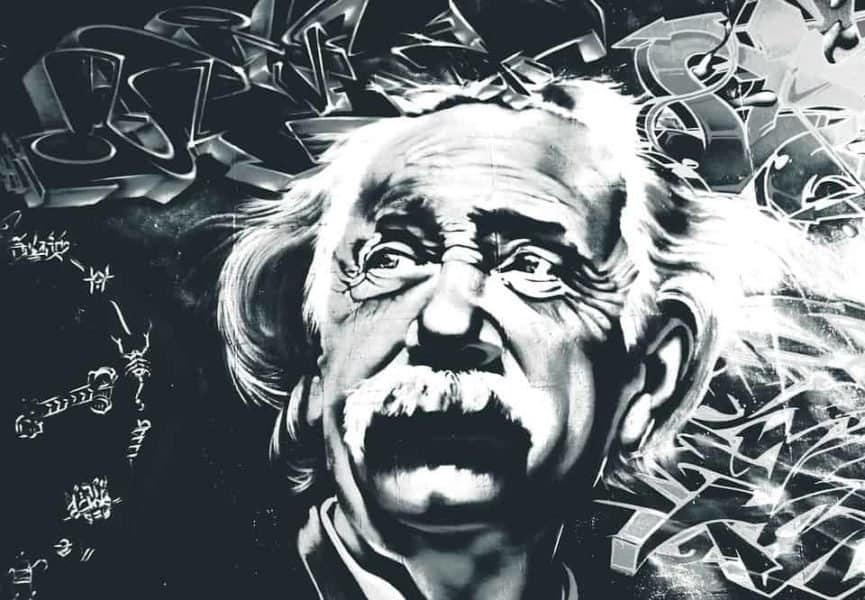Take that Niels Bohr. In eight handwritten pages, Albert Einstein lays out his objections to quantum theory, explains the thought experiment that led to the EPR paper & entanglement, and reinvents his famous saying “God does not play dice.”
A group of three Einstein letters is tipped to sell for over $200,000 at the Christie’s New York “Fine Printed Books and Manuscripts” auction on June 12, with public viewing beginning on June 7. Written in 1945 to Caltech theoretical physicist Paul Epstein in response to Epstein’s article “The Reality Problem in Quantum Mechanics,” the letters from Einstein describe his arguments about the completeness of quantum theory in both plain and scientific language.
In the first letter, Einstein rephrases his famous saying “God does not play dice,” saying instead “God tirelessly plays dice under laws which he has himself prescribed.” Here, Einstein explains he accepts that quantum mechanics “works” but he continues to think there is something fundamental underlying it that physicists do not yet understand. Einstein shows his sense of humor in this letter, asking that Paul Epstein consider his arguments carefully, adding that “anything resulting from that, [including] insults directed toward me, would give me pleasure.”
In the second letter, Einstein explains how he came up with the idea for the EPR paradox (spooky action at a distance), sharing a detailed Gedankenexperiment (thought experiment). According to science historians, this is the only time Einstein explains in his own words (and diagrams) how he came up with the entanglement argument.
–In the third letter, responding to Paul Epstein’s criticism of his previous thought experiment, Einstein creates a new thought experiment (with two more diagrams), seemingly on the fly. Reading it is like listening to Einstein think out loud.
Auction Viewing:
- 7 June, 10am -5pm
- 8 June, 10am -5pm
- 9 June, 1pm -5pm
- 10 June, 10am -5pm
- 11 June, 10am -5pm
Auction:
- 12 June, 2 pm
Location:
Christie’s, 20 Rockefeller Plaza, New York NY
Additional Background Information:
To understand Einstein’s 1945 letters about quantum physics and entanglement to Paul Epstein, you have to go back to Einstein’s battle with Niels Bohr about quantum physics at the Solvay Conference in 1927. According to science historian Robyn Arianrhod, “What they really disagreed about was the nature of reality. Bohr believed that nature was fundamentally random. Einstein did not. ‘God does not play dice with the universe,’ he declared.”
Einstein and Bohr’s dispute about the quantum world & the nature of reality carried on for decades—despite the fact that Bohr was widely considered the victor. In recent years, scientists and historians have been re-examining Einstein’s argument, and the discussion continues to this day, with multiple books published on the subject in the last year alone.
Here’s how Stanford physicist Leonard Susskind summed it up in the preface to his 2014 book Quantum Mechanics: The Theoretical Minimum: “Both Bohr and Einstein were subtle men. Einstein tried very hard to show that quantum mechanics was inconsistent; Bohr, however, was always able to counter his arguments. But in his final attack Einstein pointed to something so deep, so counterintuitive, so troubling, and yet so exciting, that at the beginning of the twenty-first century it has returned to fascinate theoretical physicists. Bohr’s only answer to Einstein’s last great discovery—the discovery of entanglement—was to ignore it.”
And here’s a quote from physicist & author Chad Orzel in a Nov 2018 article in Forbes titled “Einstein’s Complicated Relationship With Quantum Physics”: “So, while his eventual disenchantment with quantum mechanics has been exhaustively documented, Einstein in fact played a pivotal role in launching the theory. Even his departure from the field was enormously influential, as the 1935 ‘EPR’ paper he wrote with younger colleagues Boris Podolsky and Nathan Rosen provided one of the first clear examples of what’s now known as ‘entanglement,’ and provided the foundation for revolutionary work in both the philosophical foundations of quantum physics and the technology of quantum information. I won’t dwell on entanglement here… but it’s fascinating how even when Einstein was wrong about quantum physics, it turned out to be brilliantly influential.”
Here’s where Einstein’s letters to Paul Epstein comes in: In 1945, Caltech physicist Paul Epstein published an article in the American Journal of Physics called “The Reality Problem in Quantum Mechanics.” The article was about physics, philosophy, the nature of reality, and Einstein’s own EPR paper. Einstein read it, and was thrilled to have someone to kibbitz with.
Ten years after the publication of the EPR paper, Einstein was continuing to raise questions about the completeness of quantum theory that the larger physics community was studiously ignoring. “Shut up and calculate” had become the mantra of quantum physicists who were followers of Bohr’s Copenhagen Interpretation. Einstein never let his concerns go, and the 1945 letters to Paul Epstein describe Einstein’s arguments in detail.
Einstein never stopped arguing his case about quantum physics—continuing to directly influence and inspire younger physicists at Princeton—David Bohm and Hugh Everett (many worlds theory) in particular—who challenged the Copenhagen Interpretation.
Here are a few articles that elucidate the current state of the debate:
- Book review of “What Is Real: The Unfinished Quest for the Meaning of Quantum Physics” (2018)
- Einstein and the EPR Paradox
- Book review of “Einstein’s Unfinished Revolution: The Search for What Lies Beyond the Quantum” (2019).
THE FINE PRINTED BOOKS AND MANUSCRIPTS AUCTION AT CHRISTIE’S NEW YORK, FEATURING ALBERT EINSTEIN’S LETTERS TO CALTECH PHYSICIST PAUL EPSTEIN, TAKES PLACE ON JUNE 12, 2019, AT 2PM, WITH DAILY VIEWING BEGINNING ON JUNE 7.

